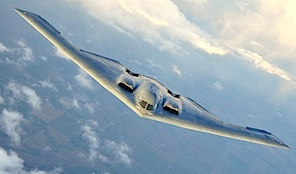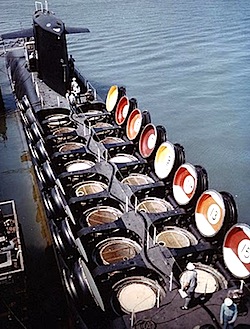|
Arsenal of Information
Dossiers:
Trump's Nuclear Posture Review
Flashpoint: North Korea
Flashpoint: NATO-Russia
UN Treaty to Prohibit Nuclear Weapons
Plutonium Pit Production at LANL
B61-12 Enhanced Nuclear Bomb
LRSO: New Nuclear Cruise Missile
Kirtland AFB Nuclear Weapons Complex
MOX / Plutonium Disposition
Fukushima Disaster and Updates
Nuke Lab Contractors Illegal Lobbying
Nuclear Testing Since 1945
Atomic Histories

Nuclear Watch Interactive Map of the
Nuclear Weapons Complex View full size
Facilities:
Kansas City Plant
Lawrence Livermore National Labs
Los Alamos National Laboratory
Nevada National Security Site
Pantex Plant
Sandia National Laboratories
Savannah River Site
Washington DC
Waste Isolation Pilot Plant (WIPP)
Y-12 National Security Complex
|
Modernizations and the 'Second Nuclear Age'

Sept 26: International Day for the Total Elimination of Nuclear Weapons*
As Nuclear Arms Modernizations Surge, Welcome to "The Second Nuclear Age"
Nuclear Watch has been documenting and reporting on the growing discrepancy between, on the one hand, this nation's avowed goal of reducing both our doctrinal reliance on nuclear weapons as well as actual nuclear weapons stockpiles, and on the other, the ballooning budgets assigned to massive, across-the-board 'modernizations' of weapons, delivery systems, and weapons production facilities. There has been a lot of criticism in the expert press and in Congress (and notably from Senator Diane Feinstein), of the Administration's recent FY 2015 budget request, which cuts funds for nuclear security worldwide while increasing funding for new nuclear warheads, ICBMs, strategic bombers, and costly additions to US nuclear weapons facilities.
The New York Times, in an editorial Sept 22 titled Backsliding on Nuclear Promises, wrote "The administration is making a foolish trade-off... Investing in nuclear security protects Americans more than unwise investment in new nuclear weapons."
"A nationwide wave of atomic revitalization"
The Times editors note: "When he first came to office, Mr. Obama was clear-sighted about nuclear dangers and ambitious in his disarmament goals... But to win Republican support for the [New Start] treaty in 2010, Mr. Obama made a Faustian bargain, promising to spend $84 billion to upgrade aging nuclear weapons over the next decade."
Now, 4 years later, "the Congressional Budget Office estimates that Mr. Obama's plans will cost $355 billion over the next decade; other studies put the price at $1 trillion over three decades."
What happened? One might say the lack of urgency on the part of the reductions side of the story allowed the inertial momentum of the well-bankrolled and well-connected nuclear weapons industry to drive the course of decision making. In fact it's also a worldwide phenomena, in a kind of mirroring in which the various nuclear adversaries can feel justified in their "modernizations" by the modernizations of the other. Russia, for example, has launched a major revamp of all their strategic systems, particularly in light of NATO moves at it's borders; (NATO moves which themselves are a response to Russian actions to intimidate and prevent Ukraine from joining NATO). Britain is facing controversy over the costs of a massive upgrade to their Trident nuclear deterrent.
China, Pakistan and India are all working on new delivery systems, most notably, hypersonic cruise missiles, already under development in the US and Russia.
We are apparently at the beginning of a new nuclear age - but not the one you might have thought was evoked in Obama's Prague speech... rather we seem to be seeing the beginning of an age of unabashed and unapologetic pursuit of more and more 'advanced' nuclear weaponry. In this new nuclear age, when the criticism is raised that our nuclear arsenals are a useless vestige of the Cold War, the response is not, "Then let's take this opportunity to get rid of the damn things" but rather, "OK, let's make them more useful and relevant."
'The Second Nuclear Age': "A world where nuclear weapons count"
Los Alamos National Lab this last summer fired a non-proliferation specialist seemingly for supporting the President's vision of a nuclear-free world and calling into question current deterrence doctrine (see 'Doyle' below). In fact, LANL is now backing a different meme- Paul Bracken's thesis described in his book "The Second Nuclear Age", that the "multiplayer nuclear world" we have now is "more dangerous than the Cold War". And to underline the point, the Wall Street Journal blurb on the cover proclaims, "We are once again in a world where nuclear weapons count." (ref)
We might have thought President Obama had picked up Ronald Reagan's mantle in his Prague speech, reiterating our national policy, in line with UN resolutions and the NPT Treaty, to move toward a world without nuclear weapons. However the US, and other nuclear powers, seem to be moving in the other direction. We might have known that "perhaps not in my lifetime" was too weak a commitment to overcome the inertial tide of the nuclear-military complexes, too conditional to hold up under geopolitical strains. After all, if JFK had used that phrase rather than "within the decade" in his challenge to land our astronauts on the moon we likely never would have made it. It's really time to rethink this, to rethink nuclear weapons altogether, before it's too late to turn it around.
References:
- Hans Kristensen and Robert Norris have done a survey of the various "modernization" programs among the nuclear powers; see a chart here.
- See a chart from the NNSA showing planned and ongoing improvements and additions to US nuclear weapons production facilities here.
Reports:
- Defense One, Oct 13: This Is a Pivotal Moment for the US Nuclear Arsenal
"In recent weeks, the nuclear spending cliff has gained increased attention and has left observers at home and abroad wondering whether the plans- which arise from disparate agency requests to replace each system individually- conflict with the administration's promise to work toward a world without nuclear weapons."
- Sept 21. New York Times: U.S. Ramping Up Major Renewal in Nuclear Arms
- Sept 22 New York Times Editorial: Backsliding on Nuclear Promises
- Sept 25. Center For Arms Control:
It's Time To Rein In Nuclear Spending
- Sept 25. Global Security: New U.S. Nuclear Warheads? Politically and Technically, a Bad Idea
- Sept 29. Guardian: Congress pushes nuclear expansion despite accidents at weapons lab
- Sept 30. Daily Beast: US & Russia Re-Arming for a New Cold War
- Oct 2. FAS: New START: Russia and the United States Increase Deployed Nuclear Arsenals
"Three and a half years after the New START Treaty entered into force in February 2011, many would probably expect that the United States and Russia had decisively reduced their deployed strategic nuclear weapons. On the contrary, the latest aggregate treaty data shows that the two nuclear superpowers both increased their deployed nuclear forces compared with March 2014 when the previous count was made."
- Oct 6. Moscow Times: Russia's Nuclear Euphoria Ignores Reality
"Dmitry Rogozin, the deputy prime minister charged with overseeing the defense industry, recently made the sensational statement that Russia would completely renew its nuclear forces by 2020."
- On the Watchblog: "Modernizing for the Second Nuclear Age" -Jay Coghlan, Nuclear Watch New Mexico
- GAO Report to Congress: Nuclear Weapons: Ten Year Budget Estimates for Modernization Omit Key Efforts, and Assumptions and Limitations Are Not Fully Transparent
- NNSA FY 2015 Budget Request
- Nuclear Watch Analysis/Compilation (PDF)
- Nuclear Watch Analysis FY2015 - PDF)
|
Massive Upgrade For B-2 Stealth
6/25/14: Air Force officials have started planning a ten billion dollar modernization of the B-2 stealth bomber fleet to include a new receiver using VLF waveform technology that allows the bomber to receive messages in the event of a high altitude electro-magnetic pulse, and outfitting the aircraft for next generation digital nuclear weapons such as the B-61 Mod 12 with the new tail kit, and Long Range Stand-Off weapons- (air-launched nuclear cruise missiles). (more)
Defense Bills Would Create Separate Fund for New Ohio-Class Nuclear Submarines
"Far-reaching implications"
"The creation of a National Sea-Based Deterrence Fund to pay for an Ohio-class ballistic missile submarine replacement could significantly alter the typically underfunded Navy shipbuilding account, while also establishing a precedent that other military services may attempt to leverage in years to come.
More: Frank Oliveri, CQ Roll Call, 6/9/14
|






 "Ours is a world of nuclear giants and ethical infants. We know more about war than we know about peace, more about killing than we know about living. We have grasped the mystery of the atom and rejected the Sermon on the Mount."
-Gen. Omar Bradley
"Ours is a world of nuclear giants and ethical infants. We know more about war than we know about peace, more about killing than we know about living. We have grasped the mystery of the atom and rejected the Sermon on the Mount."
-Gen. Omar Bradley